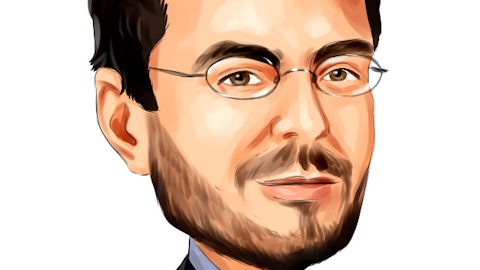So that concentration obviously will go up with dosing. And that’s the assay that we’re actually working on. Now, to get to the question about interim, there’s no interim analysis for our Phase 1 study per se, we do lines of looks at safety data routinely. But there’s no formal interim analysis. Now, we will do an interim analysis for the Phase 2/3, as I mentioned. And we’re still working out the details of what all might go into that. I think our target engagement really will probably come out of this Phase 1 study. I don’t know that we’ll need that as part of the interim on the Phase 2/3, but again, we haven’t finalized the design of the Phase 2/3 study yet.
Tom Shrader: Okay. If I can follow-up with a question from your prior life. Where are you in your thoughts on using to counter-pathology as a recruitment? Is that very much still in flux? Do you think it’s a good idea? Just you’re going to be one of the next people to design a big trial?
Eric Siemers: Right. Yes, it’s a very interesting question. I think — and the programs that are using counter-pathology as part of the inclusion/exclusion criteria. And as you know, it’s sort of a have to have a little better, but not too much. I think from a scientific standpoint, that’s very defensible. I think from a practical standpoint, I’m not sure how that would play out, especially in clinical practice. I mean, the idea that you have to be positive for amyloid and then positive for tau. And by the way, it has to be just the right amount of talent much not too little. I think that from a practical standpoint, could be quite difficult in practice. But scientifically, I understand the rationale for it.
Tom Shrader: Got it. Thanks for the detail.
Operator: Our next question will come from Colin Bristow with UBS. Your line is open, Colin.
Unidentified Analyst: This is Yang on for Colin. Thanks for taking our question. We have two questions. So the first one is that what are you specifically looking for opening attention to at the CTAD presentation, for example, for your competitors? And the second question is that with the level of co-creative slowing, do you think it is clinically relevant? Thank you.
Daniel O’Connell: Thanks. So I think — go ahead, Eric.
Eric Siemers: Well, yes. So in terms of the CTAD meeting, and I think you referred to the presentations on gantenerumab, which are consecutive days, we’re looking forward to those presentations. We’ve seen press releases for both studies. Obviously, one was positive on was negative. But to really understand the results, I think we need to see more of the data, and we’re looking forward to seeing those presentations. As far as your second question about being clinically meaningful, this is actually — has become quite an important question, I think, for the field and there’s a number of efforts to understand this better, including efforts by the Alzheimer’s Association. Generally, there’s been a relatively broad consensus that’s slowing disease progression by 25% or more is clinically meaningful.
So 27% for lecanemab based on that consensus number, it would cross that threshold. The other thing to point out is that, I don’t think anyone expects a one drug in cure this disease and so if lecanemab shows progression by 27%. The next drug that’s used in combination therapy with lecanemab, might slow at another 25%, 30%. By the time you get two or three drugs having an effect, then it will be very, very obvious that this is clinically meaningful, but you have to start some place, and you can’t start with the expectation that a single drug is going to cure the disease or got some huge effect on the disease. And I think that’s what the field is trying to understand right now. But generally, I personally think, and I think a lot of people in the field think that 27% process the threshold for clinical meaningful for us.
Unidentified Analyst: Thank you very helpful.

